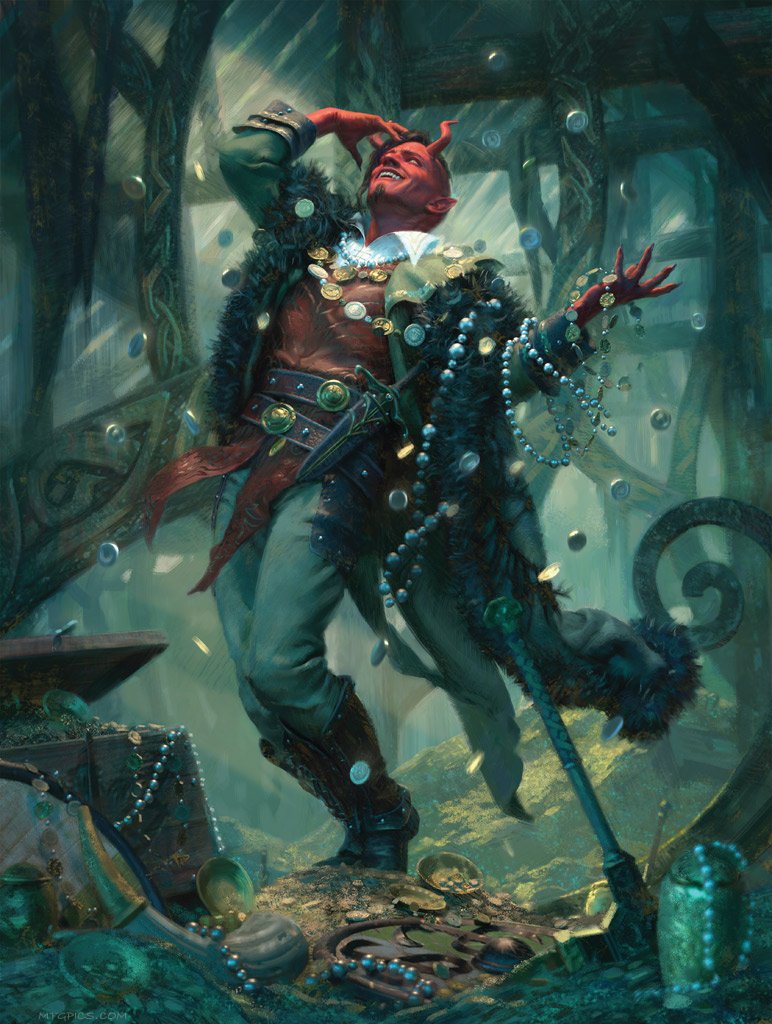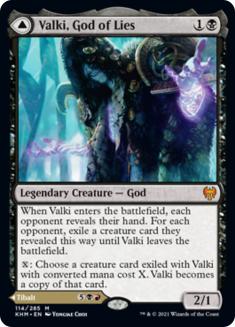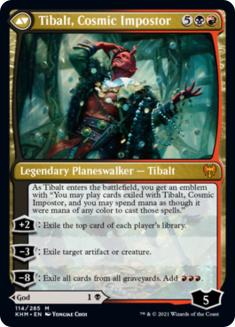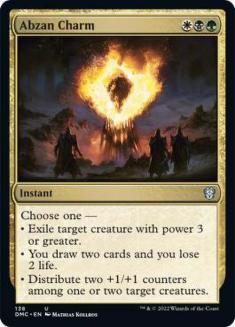It seems that on Kaldheim, Tibalt, in his best Loki impersonation, is the one making jokes at others’ expense.
Some initial murmurings on various social media platforms have been quick to highlight that Tibalt costs seven mana. Indeed, that is the number on the card. And sure, in absolute terms, this is “a lot,” but what is the power of modality?
Abzan Charm was a Constructed all-star in multiple decks and formats with cards that folks make arguments for being outliers. Take Ari Lax’s Pro Tour-winning deck as a quick highlight:
Creatures (16)
Planeswalkers (7)
Lands (24)
Spells (13)

Ari’s list played four copies of Abzan Charm, eschewing the fourth copy of Hero’s Downfall. Despite all the powerful options, Abzan Charm earned its full playset. Now, would you put the following card in your deck?
Not Color Pie Counters
WBG
Instant
Distribute two +1/+1 counters among one or two target creatures.
Of course not.
However, when you are choosing to cast Abzan Charm for its counters mode, it’s indicative that it’ll make a massive impact. By definition, the bar for casting Abzan Charm’s counter mode is stronger than “draw two cards, lose two life” or “exile target creature with power three or greater.”
Abzan Charm is the sum of its parts, and its flexibility in a variety of situations.
Now you’re probably sick of me bludgeoning you over the head with my point, and are now saying, “But Michael, this is an apples-to-oranges comparison. Valki/Tibalt have two different casting costs.”
That’s true to some extent. DFCs are certainly a different expression of modality, but the point remains that Abzan wasn’t interested in just another kill card, or just a draw-two, and certainly not a pumping effect. Combine all of those options with the opportunity cost of four slots in your deck, however, and you have an extremely high-quality Constructed card.
While less of an extreme example than I was illustrating with Abzan Charm’s counters, you likely wouldn’t put this card in your deck.
Maybe a copy or two if you really needed some top-end in your Rakdos strategy or on the splash in your three-color control deck, but yes — in some respects Tibalt is “nothing to get excited about.”
Now let’s actually talk about the card.
Bear with me a little bit. Instead of spoon-feeding you exactly what the card does, as is often tradition during preview season, I’m going to tell you how much the card costs.
Valki is a two-mana interactive creature. You can put four copies of it in your deck, and cast it as your two-drop on Turn 2 if it’s in your opening hand. By definition, you now also have four copies of a seven-mana planeswalker in your deck. If you have seven mana and Valki, God of Lies, you can cast it as Tibalt, Cosmic Impostor. A reasonable percentage of the time, this seven-mana planeswalker will win you the game.
Yes, seven mana is “a lot.”
We think of seven mana as “a lot” because it’s a heuristic we use as an expression of opportunity cost. If I choose to put four copies of Ugin, the Spirit Dragon in my deck, I am incurring the risk of drawing Ugin in my opening hand or any other draw step and letting it “rot” until I have eight mana and I can cast it. It could be any other cheaper card that I can cast in a higher frequency of games. The reason I will choose to play Ugin is because it is extremely powerful and often wins the games where I cast it.
Valki/Tibalt, while not as pound-for-pound powerful as Ugin, does not have this problem.
Now that I’ve inadvertently given lessons on card evaluation and deckbuilding, I suppose we can actually examine the text on the cards. Hopefully I’ve given you sufficient reason to pay attention. Now let’s examine Valki.
Is Valki the end-all be-all to play four copies for the reasons I’ve outlined above? No, because it does have weaknesses.
Your opponent might not be playing any creatures and it can miss due to its restrictions. This is weaker in certain matchups and in specific metagames. Of course, this is mitigated by being a DFC, and even if you miss Valki can trade off, generate pressure, or attack planeswalkers. At the end of the day though, sometimes you’ll just end up with a 2/1.
What’s the upside?
X: Choose a creature card exiled with Valki with converted mana cost X. Valki becomes a copy of that card.
While not applicable in Standard, this is still an effective illustration of how powerful Valki can be, especially in Historic. The upside is that Valki can not only disrupt your opponent but singlehandedly take over games, in the case of leveraging Uro (or Kroxa, Titan of Death’s Hunger!) as early as the third turn.
Until now, I’ve glossed over Tibalt’s actual abilities, so let’s at least acknowledge them.
As Tibalt enters the battlefield, you get an emblem with “You may play cards exiled with Tibalt, Cosmic Impostor, and you may spend mana as though it were mana of any color to cast those spells.
Tibalt’s emblem, while unique, is also intuitive to understand.
The most common scenario for Tibalt is you will cast it and exile your opponent’s best creature. Now your opponent has a single turn of opportunity to kill Tibalt or you will cast that creature and plus the Tibalt, effectively putting you up four cards in summation. Is it on the level of Ugin’s dominance or catch-up power? Not quite, but that’s still a lot to show for a single turn cycle.
On stable battlefields, Tibalt’s +2 effectively draws two cards, puts it up to a nearly unkillable seven loyalty, and the game will snowball from there.
Tibalt’s ultimate is fast, and should be enough cards to end the game immediately if you must keep playing after two pluses.
Tibalt’s emblem scales well in multiples, another boon of getting to play four copies in your deck. Should the first die after minusing, the second can repeat the play pattern and put your opponent back in the squeeze.
So you’ve hyped up this card a lot. What kind of decks can I put it in?
Good question. Let’s start here:
Creatures (20)
- 2 Murderous Rider
- 4 Bonecrusher Giant
- 2 Ox of Agonas
- 4 Mire Triton
- 4 Kroxa, Titan of Death's Hunger
- 4 Valki, God of Lies
Lands (20)
Spells (20)

Valki cleanly slides into Standard Rakdos Midrange, upgrading Robber of the Rich. This is another potent late-game weapon to pair with the already immense grinding power of Rakdos’s escape cards, Ox of Agonas and Kroxa, Titan of Death’s Hunger. Blightstep Pathway is another massive upgrade to this deck, as its mana was the weakest component.
Creatures (18)
- 2 Young Pyromancer
- 4 Stitcher's Supplier
- 4 Dreadhorde Arcanist
- 4 Kroxa, Titan of Death's Hunger
- 4 Valki, God of Lies
Lands (21)
Spells (21)
- 4 Thoughtseize
- 4 Claim
- 1 Bedevil
- 2 Spark Harvest
- 3 Claim the Firstborn
- 4 Village Rites
- 1 Spikefield Hazard
- 2 Agadeem's Awakening
Sideboard

Similarly, Historic’s Rakdos Arcanist (Lurrus) will also welcome Valki. It can crush Uro on-curve or be a critical mana sink that can finally leverage Phyrexian Tower effectively. Despite playing four seven-mana planeswalkers in your deck, your deck will remain legal for Lurrus’s companion condition.
Finally, Valki’s secret mode:
Creatures (26)
- 2 Bloodsoaked Champion
- 4 Scrapheap Scrounger
- 4 Dread Wanderer
- 2 Spawn of Mayhem
- 4 Knight of the Ebon Legion
- 3 Rankle, Master of Pranks
- 4 Murderous Rider
- 3 Valki, God of Lies
Lands (24)
Spells (10)

It can just be a mono-black card. Again, it won’t come up often that you’ll be casting a seven-mana planeswalker in Pioneer, but when it’s virtually free, you’ll be happy that you played the God of Lies on those rare occasions the games do go incredibly deep.
That makes three formats where Valki fits in effortlessly. I think it’s fair to say that this time Tibalt is going to be the one doing the laughing.





